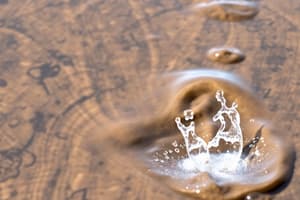Podcast
Questions and Answers
What is the origin of the word 'environment'?
What is the origin of the word 'environment'?
- Derived from the Greek word 'environs'
- Derived from the Latin word 'environmentem'
- Derived from the German word 'umwelt'
- Derived from the French word 'environner' (correct)
What is the core aspect of environment according to Albert Einstein?
What is the core aspect of environment according to Albert Einstein?
- Everything that isn't me (correct)
- The interaction between living and non-living things
- The physical components of the environment
- The sum of water, air, and land
What is the focus of Environmental Engineering?
What is the focus of Environmental Engineering?
- To design buildings and infrastructure
- To care for and restore the natural environment (correct)
- To study the effects of pollution on human health
- To study the natural environment
What is the primary goal of Environmental Engineering?
What is the primary goal of Environmental Engineering?
What are the main components of the environment?
What are the main components of the environment?
What is the scope of Environmental Engineering?
What is the scope of Environmental Engineering?
What is the role of Environmental Engineering in the protection of public health?
What is the role of Environmental Engineering in the protection of public health?
What is the ultimate goal of Environmental Engineering?
What is the ultimate goal of Environmental Engineering?
When was the descriptive title of 'environmental engineer' first used?
When was the descriptive title of 'environmental engineer' first used?
What was the main reason for King Edward I's prohibition of burning sea coal in 1273?
What was the main reason for King Edward I's prohibition of burning sea coal in 1273?
What percentage of people in the third world do not have sanitary drinking water supplies or wastewater treatment?
What percentage of people in the third world do not have sanitary drinking water supplies or wastewater treatment?
What was the significant increase in the 1950s to 1960s?
What was the significant increase in the 1950s to 1960s?
What is the primary goal of environmental engineering?
What is the primary goal of environmental engineering?
When was the Environmental Protection Agency (EPA) created?
When was the Environmental Protection Agency (EPA) created?
What is the estimated daily cost to provide world-wide sanitary services?
What is the estimated daily cost to provide world-wide sanitary services?
What is the main discipline that environmental engineering draws knowledge from?
What is the main discipline that environmental engineering draws knowledge from?
Flashcards are hidden until you start studying
Study Notes
Definition of Environment
- The word "environment" is derived from the French word "environner," meaning "to surround."
- The environment is defined as the sum of water, air, land, and their interrelationships with humans, living organisms, and materials.
- The main components of the environment are:
- Atmosphere
- Hydrosphere
- Lithosphere
- Biosphere
Environmental Engineering
- Environmental engineering is the application of science and engineering principles to care for and restore the natural environment and solve environmental problems.
- It deals with air pollution control, hazardous waste management, wastewater treatment, and water treatment.
- Environmental engineering involves planning, design, construction, and operation of equipment, systems, and structures for environmental protection.
- The profession has a long history, with roots in civil engineering, public health, ecology, chemistry, and meteorology.
History of Environmental Engineering
- The descriptive title "environmental engineer" was not used until the 1960s.
- The roots of environmental engineering go back to ancient civilizations, including Crete and Assyria, which had sewer systems.
- Roman sewers were designed as storm sewers but used as sanitary sewers.
- In 1273, King Edward I prohibited the burning of sea coal due to smoke and fog mixtures.
- In the 1950s-1960s, there was a significant increase in waste discharge into the environment, and pesticide use increased without sufficient testing.
- The 1960s saw increased social awareness of environmental problems, leading to the creation of the Environmental Protection Agency (EPA) in 1970.
Goals of Environmental Engineering
- The goal of environmental engineering is to ensure sustainable development and the use of water, land, and air resources.
- It aims to provide sanitary drinking water supplies and wastewater treatment worldwide.
Studying That Suits You
Use AI to generate personalized quizzes and flashcards to suit your learning preferences.




